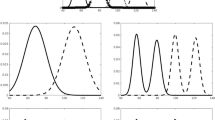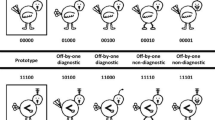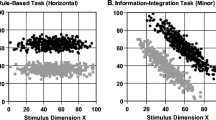Abstract
The problem of how people process novel and unexpected information—deep learning (Ohlsson in Deep learning: how the mind overrides experience. Cambridge University Press, New York, 2011)—is central to several fields of research, including creativity, belief revision, and conceptual change. Researchers have not converged on a single theory for conceptual change, nor has any one theory been decisively falsified. One contributing reason is the difficulty of collecting informative data in this field. We propose that the commonly used methodologies of historical analysis, classroom interventions, and developmental studies, although indispensible, can be supplemented with studies of laboratory models of conceptual change. We introduce re-categorization, an experimental paradigm in which learners transition from one definition of a categorical concept to another, incompatible definition of the same concept, a simple form of conceptual change. We describe a re-categorization experiment, report some descriptive findings pertaining to the effects of category complexity, the temporal unfolding of learning, and the nature of the learner’s final knowledge state. We end with a brief discussion of ways in which the re-categorization model can be improved.






Similar content being viewed by others
Notes
For convenience, we will use the term “definition” to refer to the mental representation of the meaning of a concept. We do not mean to imply that such a representation consists of a list of necessary and sufficient conditions for category membership.
References
Ashby, F. G., & Maddox, W. T. (2005). Human category learning. Annual Review of Psychology, 56, 149–178.
Carey, S. (2009). The origin of concepts. New York: Oxford University Press.
Chi, M. T. H. (2005). Commonsense conceptions of emergent processes: Why some misconceptions are robust. The Journal of the Learning Sciences, 14, 161–199.
Chi, M. T. H. (2008). Three types of conceptual change: Belief revision, mental model transformation, and categorical shift. In S. Vosniadou (Ed.), Handbook of research on conceptual change (pp. 61–82). Hillsdale, NJ: Erlbaum.
Cohen, H., & Lefebvre, C. (Eds.). (2005). Handbook of categorization in cognitive science. Amsterdam, The Netherlands: Elsevier.
Comins, N. F. (2001). Heavenly errors: Misconceptions about the real nature of the universe. New York: Columbia University Press.
Cosejo, D. G., Oesterreich, J., & Ohlsson, S. (2009). Re-categorization: Restructuring in categorization. In N. A. Taatgen & H. van Rijn (Eds.), Proceedings of the 31th annual conference of the Cognitive Science Society. Austin, TX: Cognitive Science Society.
Craig, S., & Lewandowsky, S. (2012). Whichever way you choose to categorize, working memory helps you learn. The Quarterly Journal of Experimental Psychology, 65(3), 439–464.
DiSessa, A. A. (1993). Toward and epistemology of physics. Cognition and Instruction, 10, 105–225.
DiSessa, A. A., Gillespie, N. M., & Esterly, J. B. (2004). Coherence versus fragmentation in the development of the concept of force. Cognitive Science, 28, 843–890.
Duit, R., & Treagust, D. F. (2003). Conceptual change: A powerful framework for improving science teaching and learning. International Journal of Science Education, 25(6), 671–688.
Dunbar, K. (2001). The analogical paradox: Why analogy is so easy in naturalistic settings, yet so difficult in the psychological laboratory. In D. Gentner, K. Holyoak, & B. Kokinov (Eds.), The analogical mind: Perspectives from cognitive science (pp. 313–334). Cambridge, MA: MIT Press.
Dunbar, K., & Blanchette, I. (2001). The in vivo/in vitro approach to cognition: The case of analogy. TRENDS in Cognitive Sciences, 5, 334–339.
Flynn, E., & Siegler, R. (2007). Measuring change: Current trends and future directions in microgenetic research. Infant and Child Development, 16, 135–149.
Gopnik, A., & Meltzoff, A. N. (1997). Words, thoughts, and theories. Cambridge, MA: MIT Press.
Gruber, H. E. (1974). Darwin on man: A psychological study of scientific creativity. London, UK: Wildwood House.
Kitcher, P. (1993). The advancement of science. New York: Oxford University Press.
Kuhn, T. S. (1970). The structure of scientific revolutions (2nd ed.). Chicago, IL: University of Chicago Press.
Lafond, D., Lacouture, Y., & Cohen, A. L. (2009). Decision-tree models of categorization response times, choice proportions, and typicality judgments. Psychological Review, 116(4), 833–855.
Lewin, K., & Lippitt, R. (1938). An experimental approach to the study of autocracy and democracy: A preliminary note. Sociometry, 1, 292–300.
Limón, M. (2001). On the cognitive conflict as an instructional strategy for conceptual change: a critical appraisal. Learning and Instruction, 11, 357–380.
Margolis, E., & Laurence, S. (Eds.). (1999). Concepts: Core readings. Cambridge, MA: MIT Press.
Markman, A. B., & Ross, B. H. (2003). Category use and category learning. Psychological Bulletin, 129, 592–613.
Nersessian, N. J. (2008). Creating scientific concepts. Cambridge, MA: MIT Press.
Ohlsson, S. (2009). Resubsumption: A possible mechanism for conceptual change and belief revision. Educational Psychologist, 44, 20–40.
Ohlsson, S. (2011). Deep learning: How the mind overrides experience. New York: Cambridge University Press.
Phillips, S., & Tomie, A. (2007). Children’s performance on and understanding of the balance scale problem: The effects of parental support. Infant and Child Development, 16, 95–117.
Popper, K. (1959/1972). The logic of scientific discovery (translation by author, revised version). London, UK: Hutchinson.
Posner, G. J., Strike, K. A., Hewson, P. W., & Gertzog, W. A. (1982). Accommodation of a scientific conception: Toward a theory of conceptual change. Science Education, 66, 211–227.
Rakison, D. H., & Poulin-Dubois, D. (2001). Developmental origin of the animate–inanimate distinction. Psychological Bulletin, 127(2), 209–228.
Ross, B. H., Taylor, E. G., Middleton, E. L., & Nokes, T. J. (2008). Concept and category learning in humans. Learning and Memory: A Comprehensive Reference, 2, 535–556.
Schwartz, B., Perret-Clermont, A.-N., Trognon, A., & Marro, P. (2008). Emergent learning in successive activities. Pragmatics & Cognition, 16, 57–87.
Shipstone, D. M. (1984). A study of children’s understanding of electricity in simple DC circuits. European Journal of Science Education, 6, 185–198.
Sinatra, G. M., & Pintrich, P. R. (Eds.). (2003). Intentional conceptual change. Mahwah, NJ: Lawrence Erlbaum.
Thagard, P. (1992). Conceptual revolutions. Princeton, NJ: Princeton University Press.
Vosniadou, S., Baltas, A., & Vamvakoussi, X. (Eds.). (2007). Reframing the conceptual change approach to learning and instruction. Amsterdam, The Netherlands: Elsevier Science.
Vosniadou, S., & Brewer, W. F. (1992). Mental models of the earth: A study of conceptual change in childhood. Cognitive Psychology, 24, 535–585.
Voutsina, C. (2012). Procedural and conceptual changes in young children’s problem solving. Educational Studies in Mathematics, 79, 193–214.
Acknowledgments
The work reported in this article was supported, in part, by Award N00014-09-1-0125 from the Office of Naval Research (ONR), US Navy, to the first author. No endorsement should be inferred. We thank Bettina Chow for assistance in the development of the experimental stimuli and Justin Oesterreich for programming the first re-categorization experiment in the E-Prime laboratory software.
Author information
Authors and Affiliations
Corresponding author
Rights and permissions
About this article
Cite this article
Ohlsson, S., Cosejo, D.G. What Can Be Learned From a Laboratory Model of Conceptual Change? Descriptive Findings and Methodological Issues. Sci & Educ 23, 1485–1504 (2014). https://doi.org/10.1007/s11191-013-9658-6
Published:
Issue Date:
DOI: https://doi.org/10.1007/s11191-013-9658-6




